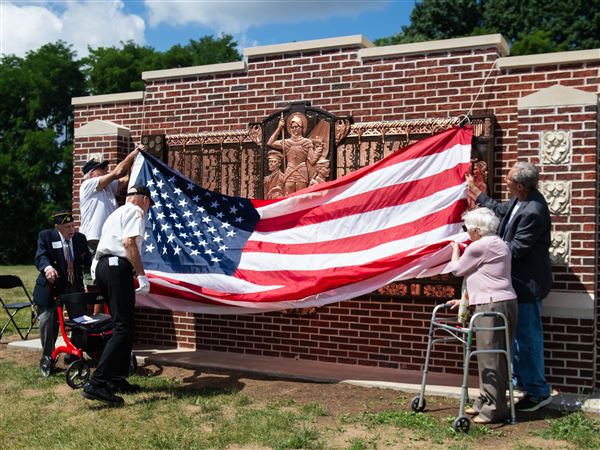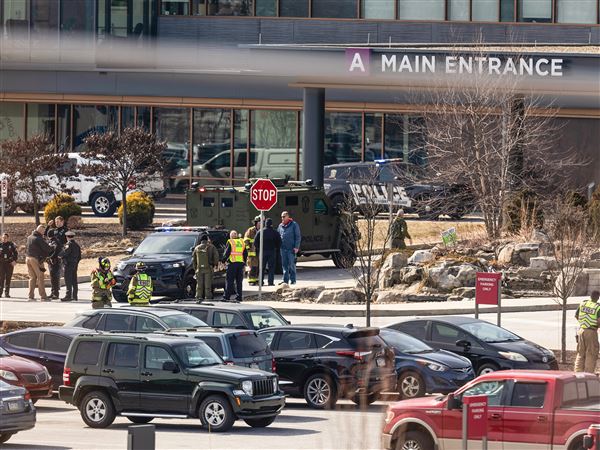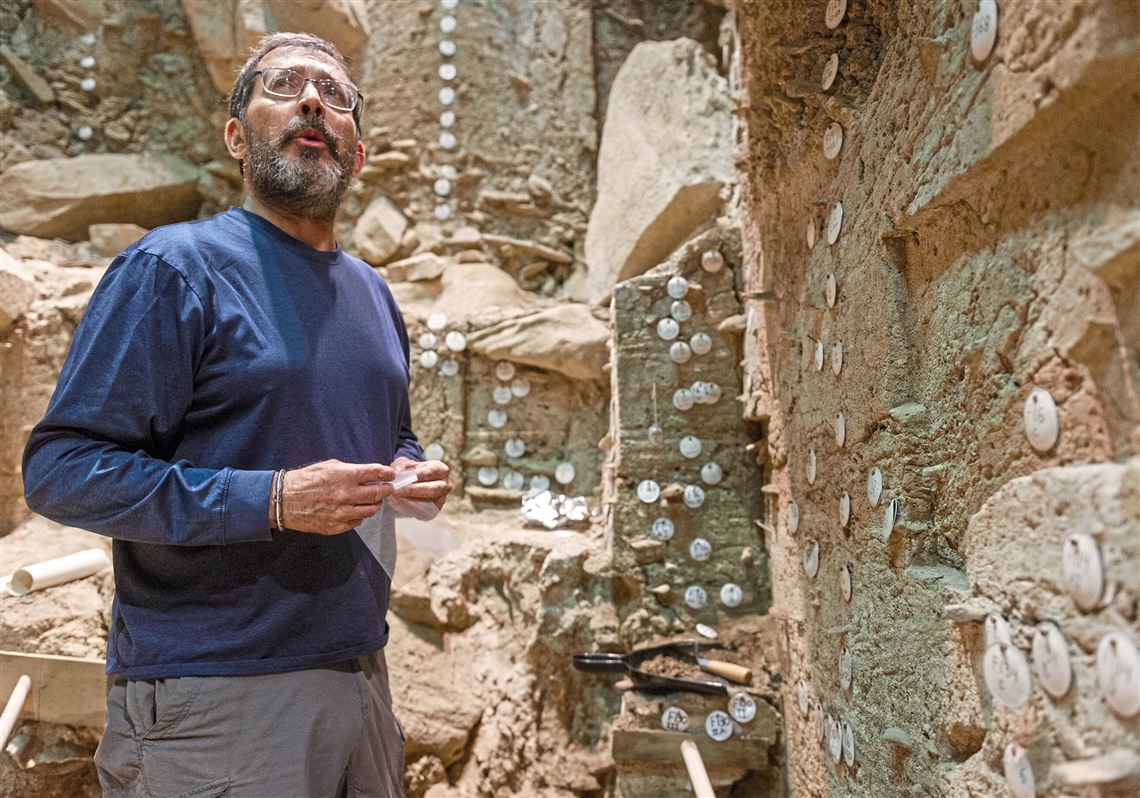For the first time in three years, digging has resumed in the woods at the Meadowcroft Rockshelter, an ancient campsite near Avella where humans have taken refuge for at least 19,000 years.
Millennia ago, rains, river water and wind carved the site into the side of a sheer cliff jutting over Cross Creek, a tributary of the Ohio River, in what’s now Washington County.
Now, visitors to the cliff are getting a rare opportunity to view archaeology in action.
This summer’s publicly viewable dig is the latest installment in a nearly 50-year project to tell the whole story of what happened at Meadowcroft Rockshelter. One of the oldest known examples of a human presence in North America, the pit at Meadowcroft presents scholars with an unparalleled wealth of material to assist in narrating the deep history of the continent.
When the project began in 1973, James Adovasio, then a young archaeologist at the University of Pittsburgh, brought a rotating group of a dozen or so anthropology and archaeology students to excavate the site. After five years of 80-hour work weeks, they had turned up 20,000 artifacts, 956,000 animal remains and 1.4 million plant remains.
Fossils, bones, fire pits, flint knives, arrowheads, glass beads, stone tools, shards of pottery, charcoal, gunpowder, even beer cans — all of them were there.
Mr. Adovasio, 78, is now director of Archaeology at the Senator John Heinz History Center, which operates the rockshelter.
On Wednesday morning, he and Allen Quinn, a mostly retired archaeologist who still works on and off at Meadowcroft and studied with Mr. Adovasio at Pitt, returned to the site to excavate, bag and catalog sediment from an eroded sandstone wall. The roof of the site’s enclosure leaked in a storm last fall, and the rain caused some of the sediment to slosh around.
Staff at the site managed to patch the leak and temporarily buttress the wall with wooden supports soon after noticing the instability. But they knew that it would only be a matter of time before the whole thing had to be excavated and repaired. Should even a small segment of the rockshelter slip, crack or collapse, tens of thousands of years of information about human, animal and plant life could be lost in a matter of seconds.
“Context is so important in archaeology,” said David Scofield, director of the Meadowcroft Rockshelter and Historic Village, “and once a chunk falls out, you lose all the context, all the stratigraphy [the study of layers of rock and artifacts encased in them] in the site, that places it at a specific time and any artifacts or cultural features in that.
“If you can’t associate that with a specific layer, you lose all the context.”
Samples taken over the course of the summer’s excavation will, as is typical in such work, be sifted for ancient artifacts and for prehistoric plant and animal remains. The Heinz Center will then send the materials to professor Eske Willerslev’s Centre for GeoGenetics in Denmark, based at the University of Copenhagen, to be scanned for evidence of human DNA.
“The people who came here were just like you and I,” Mr. Adovasio said. “They had the same physical and mental capacities. Albeit modified by time, they had the same kind of problems that we do. Figuring out how they adjusted to changes in the environment, how they adjusted their technologies to the environment, is part of the narrative that the story of the rockshelter tells.”
On Thursday morning, Mr. Adovasio was perched up high on a wooden landing at the rockshelter— a kind of archaeologist’s crow’s nest above the 20 foot pit — documenting the samples that had been collected so far that day. Ziploc bags of dirt and reams of graph paper penciled with rows of data were strewn across the table in front of him.
Mr. Quinn, who has worked at the site for the last 38 years, stood in the pit below, glacially troweling away at the problematic sandstone wall. He was intensely focused as he followed, centimeter by centimeter, a color-coded map of the layers of rock in front of him. Boulders hung overhead — huge slabs of rock that too hasty a movement of the trowel would bring crashing down. A good archaeologist knows not to fool around with 19,000 years of potential energy.
“If you think about human history as a book, a big thick book,” said Mr. Quinn, “and each of these layers [of rock] represent a page or a chapter of the book, at most archeological sites, you’ll get a page or you’ll get a chapter, two chapters maybe. Here you get the entire book.”
The site is about an hour’s drive, with moderate traffic, southwest of Pittsburgh on Interstate 79. Visitors will know they’re close when the number of tanker trucks on the road thins out and the tree coverage thickens. Forest rolls all around the rockshelter, interrupted only by the hard angles of the site’s midcentury modern enclosure.
The building was designed in 2007 by local architect Robert Pfaffmann in the style and palette of Frank Lloyd Wright. The structure is in place mainly to shield the excavation pit from weather — although, as last year’s rain would attest, it isn’t fool-proof. It also gives visitors a comfortable ledge on which to stand and watch the archaeologists at work.
For a long time, Ryan Kaboly, 25, had been fascinated by the story of how humans first came to America. Recently, he heard about the rockshelter on a podcast and decided to stop there while driving to Montana from Bethlehem, Pa., to start work as a backpacking guide in Glacier National Park.
Mark and Anne Murphy, both 67, drove to the site from Lenoir City, Tenn., on the way to a family reunion in the area.
“During COVID, we watched a series on the Great Courses about ancient civilizations,” said Ms. Murphy, “and one of the instructors talked about this site.”
The Murphys had been hoping to swing by the rockshelter for some time, but last time they passed through the area, the site had closed for the winter. While on the road to Western Pennsylvania last week, they were finally able to make the visit.
Since Mr. Adovasio’s return, the rockshelter, according to Mr. Scofield, has been averaging anywhere from 30 to 150 visitors a day.
Admission is $15 for adults and $7 for kids, Wednesdays to Sundays, from 10 a.m. to 4 p.m., through July 31.
The dig is also being livestreamed for free on the Heinz History Center’s YouTube channel.
Zachary Groz: zgroz@post-gazette.com.
First Published: June 13, 2022, 10:00 a.m.
Updated: June 13, 2022, 10:04 a.m.





















